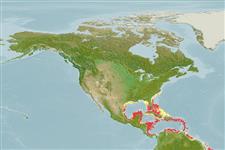>
Ovalentaria/misc (Various families in series Ovalentaria) >
Opistognathidae (Jawfishes)
Etymology: Opistognathus: Greek, opisthe = behind + Greek, gnathos = jaw (Ref. 45335); to the very elongate upper jaw of the type species of the genus, Opistognathus nigromarginatus (Ref. 128653).
More on author: Poey.
Environment: milieu / climate zone / profondeur / distribution range
Écologie
marin récifal; profondeur 0 - 44 m (Ref. 26893). Tropical
Western Atlantic: southern Florida, USA and Bahamas to northern South America. Including Antilles but absent in Jamaica (Ref. 26938).
Taille / Poids / Âge
Maturité: Lm ? range ? - ? cm
Max length : 20.0 cm TL mâle / non sexé; (Ref. 7251)
Épines dorsales (Total) : 11; Rayons mous dorsaux (Total) : 16 - 17; Épines anales: 3; Rayons mous anaux: 14 - 16. Black spot on upper half of dorsal fin from sixth or seventh to ninth spines. Males have long, upcurved extension of maxillary bone marked with black bands (Ref. 26938). Females appear to lack the long double-banded maxilla, and there is only a single blackish band at the corner of the mouth (Ref. 13442).
Body shape (shape guide): elongated.
Inhabits sandy bottoms near coral reefs (Ref. 9710). Feeds on gastropods, crabs and fishes (Ref. 13628). Monogamous (Ref. 52884). Oviparous, mouthbrooding by males (Ref. 205).
Life cycle and mating behavior
Maturité | Reproduction | Frai | Œufs | Fécondité | Larves
Displays facultative monogamy where males are constrained to mate with a single female due to resource limitation (Ref. 52884). Males incubate the eggs in the mouth (Ref. 205).
Robins, C.R. and G.C. Ray, 1986. A field guide to Atlantic coast fishes of North America. Houghton Mifflin Company, Boston, U.S.A. 354 p. (Ref. 7251)
Statut dans la liste rouge de l'IUCN (Ref. 130435: Version 2025-1)
Menace pour l'homme
Harmless
Utilisations par l'homme
Pêcheries: commercial; Aquarium: Commercial
Outils
Articles particuliers
Télécharger en XML
Sources Internet
Estimates based on models
Preferred temperature (Réf.
123201): 25.3 - 28.1, mean 27 °C (based on 180 cells).
Phylogenetic diversity index (Réf.
82804): PD
50 = 0.5000 [Uniqueness, from 0.5 = low to 2.0 = high].
Bayesian length-weight: a=0.00389 (0.00180 - 0.00842), b=3.12 (2.94 - 3.30), in cm total length, based on all LWR estimates for this body shape (Ref.
93245).
Niveau trophique (Réf.
69278): 3.6 ±0.6 se; based on diet studies.
Fishing Vulnerability (Ref.
59153): Low vulnerability (10 of 100).
🛈
Nutrients (Ref.
124155): Calcium = 86 [47, 127] mg/100g; Iron = 0.652 [0.404, 1.063] mg/100g; Protein = 18.5 [17.5, 19.5] %; Omega3 = 0.0952 [, ] g/100g; Selenium = 34.8 [17.1, 65.0] μg/100g; VitaminA = 97.3 [34.5, 269.5] μg/100g; Zinc = 1.63 [1.12, 2.23] mg/100g (wet weight);
